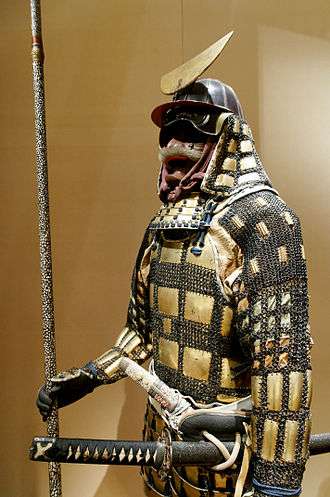Tatami (Japanese armour)
Tatami (畳具足), or tatami gusoku (from tatamu 畳む, "to fold") and gusoku (meaning full suit of armour),[1] was a type of lightweight portable folding Japanese armour worn during the feudal era of Japan by the samurai class and their foot soldiers (ashigaru). The Tatami dō (a foldable cuirass) or the tatami katabira (an armoured jacket) were the main components of a full suit of tatami armour.[2]

Structure
A tatami gusoku (complete suit of folding armor) includes a tatami dō or tatami katabira (jacket) and a tatami kabuto (helmet) chochin kabuto,[3] or tatami zukin (hood) or similar type of head protection along with the other related parts of a full suit of Japanese armour. Collapsible head protection such as hachi gane and other collapsible armor are also tatami armor;[4] a traditional kabuto could also be part of a tatami gusoku.
Tatami armour was lightweight, portable, convenient for transportation, and they were manufactured inexpensively for the ashigaru light infantry.[5] Tatami armours were worn by all samurai classes from the highest class to the lowest class. The higher class samurai wore elaborate armour[1] while the lower class samurai and retainers wore simpler versions.
In his book Arms and Armor of the Samurai: The History of Weaponry in Ancient Japan[2] Ian Bottomley shows a karuta tatami do and a karuta tatami kabuto (p. 88), and discusses different types of tatami dō karuta gane dō and kikko gane dō on p. 91. George Cameron Stone shows a kikko tatami armor on p. 606 of his book A glossary of the construction, decoration, and use of arms and armor.[4]
Types of Tatami armour
Karuta tatami armour
- Karuta[5] are small lacquered square or rectangular iron (sometimes leather) plates usually connected together by chainmail and sewn to a cloth backing.[6]
- Edo period samurai folding suit of armor tatami gusoku completely matched set with karuta tatami dō and chochin kabuto.
- Karuta tatami dō and karuta zukin (hood).
- Edo period samurai karuta tatami dō in the hara-ate style.
- Karuta katabira.
Kikko tatami armour
- Kikko are small iron or leather hexagon plates[1] usually connected together by kusari or chainmail, and sewn to a cloth backing.[2]
 Edo period tetsu kikko tatami dō. A lightweight portable folding tatami cuirass, made from small metal hexagonal plates (kikko), sewn to a cloth backing.
Edo period tetsu kikko tatami dō. A lightweight portable folding tatami cuirass, made from small metal hexagonal plates (kikko), sewn to a cloth backing.- Edo period kikko tatami dō. A cuirass with small hexagon armor plates kikko. The kikko are connected to each other by chainmail and sewn to a cloth backing.
- Edo period kikko tatami dō, shown folded up.
 Kikko katabira.
Kikko katabira.
Kusari tatami armour
 Kusari tatami dō, a cuirass made from chain armour shown next to a traditional iron cuirass.
Kusari tatami dō, a cuirass made from chain armour shown next to a traditional iron cuirass.- Kusari tatami gusoku, a suit of chain armour.
- Kusari tatami gusoku, a suit of chain armour
See also
- Dou (dō)
- Plated mail
- Brigandine
- Kikko (Japanese armour)
- Karuta (Japanese armour)
- Kusari (Japanese mail armour)
- Japanese armour
References
- Bryant, Anthony J.; McBride, Angus (2010). The Samurai: Warriors of Medieval Japan, 940-1600. Osprey Publishing. p. 63.
- Bottomley, Ian (1993). Hopson, Anthony (ed.). Arms and Armor of the Samurai: The History of Weaponry in Ancient Japan. Crescent Books. pp. 88, 91, 92. ISBN 9780517103180.
- Louis, Thomas; Ito, Tommy (2008). Samurai: The Code of the Warrior. Sterling Publishing Company, Inc. p. 98. ISBN 9781402763120.
- Stone, George Cameron (1999). Glossary of the Construction, Decoration and Use of Arms and Armor in All Countries and in All Times. Courier Corporation. p. 606. ISBN 9780486407265.
- Bryant, Anthony J. (20 February 2013). McBride, Angus (ed.). Samurai 1550-1600. Bloomsbury Publishing. p. 59. ISBN 9781472801777.
- Turnbull, Stephen (22 May 2007). Warriors of Medieval Japan. Bloomsbury USA. p. 138. ISBN 9781846032202.
- The Encyclopedia Americana: A Library of Universal Knowledge. 15. Encyclopedia Americana Corporation. 1919. pp. 742–744.
- Dean, Bashford (1920). Helmets and Body Armor in Modern Warfare. New York, N.Y.: Yale University Press, Metropolitan Museum of Art. p. 172.
External links
| Wikimedia Commons has media related to Tatami (Japanese armour). |